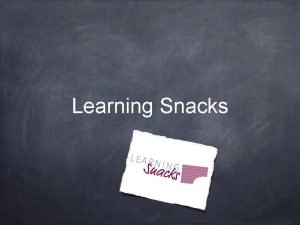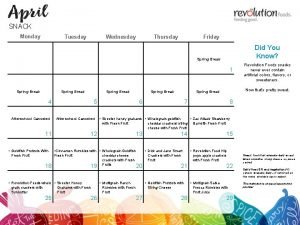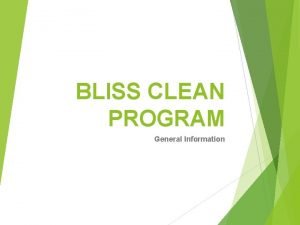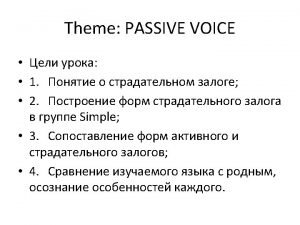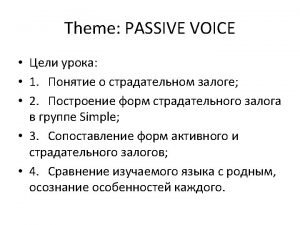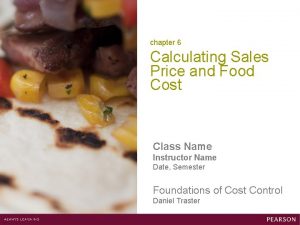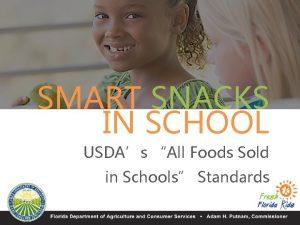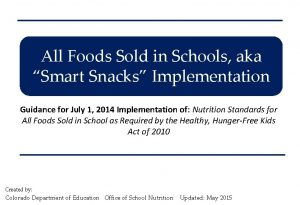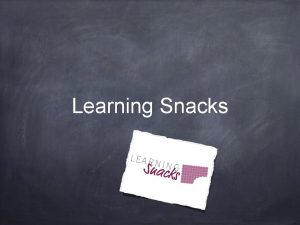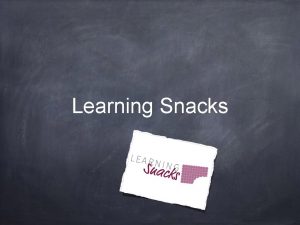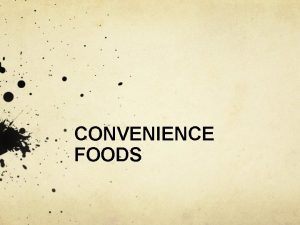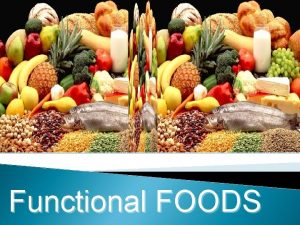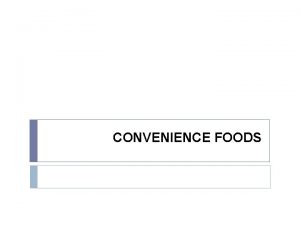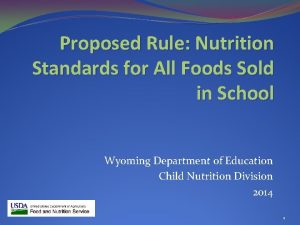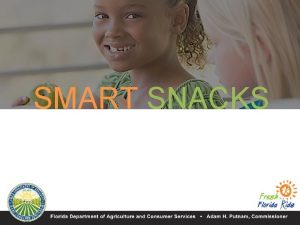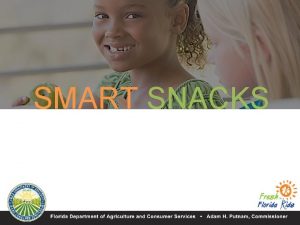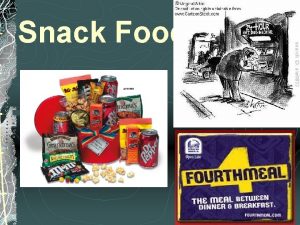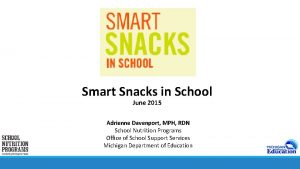SMART SNACKS IN SCHOOL USDAs All Foods Sold



























- Slides: 27

SMART SNACKS IN SCHOOL USDA’s “All Foods Sold in School” Nutrition Standards New for Snacks and Beverages

Presentation Outline • Overview of USDA’s Smart Snacks in School Nutrition Standards • • • What is the purpose When and where do the standards apply Why are the standards necessary How were the standards determined “Smart Snacks in School” Timeline Student Nutrition Associations’ (SNA) Comments • Nutrition Standards for Foods • General nutrition standards • Food accompaniments • Fundraisers • Nutrition Standards for Beverages • Beverages allowed for all grade levels • Caffeine standards • Comparison of Before and After New Standards • Monitoring and Compliance • Implementation and Support • Resources for More Information

New Nutrition Standards Overview As a part of the Healthy Hunger-Free Kids Act of 2010, the new Smart Snacks in School rules affect “competitive foods” sold in schools, which include vending machines, a la carte lunch lines, and in student stores. These snacks and beverages are purchased outside of the regular meals provided by the school, and “compete” with the nutritionally regulated and reimbursable national school lunch and breakfast programs.

Potential effects of Smart Snack Standard Implementation • Compromise revenue stream • Establish a uniform description of healthy snacks on campus • Broaden the scope of the School Nutrition Director and Administration staff • Promote students bringing their own snacks • Question who, what, and how nutrition education is provided • Clarify fundraising exemption by MDE

What do the new standards do? • Allow schools to offer healthier snack foods and limit ”junk foods” • Set standards for fat, saturated fat, sugar and sodium content • Promote snacks that have main ingredient listed as either: • Whole grain • Low-fat dairy • Fruit • Vegetable • Protein

Where do the standards apply? School campus: All areas of the property under the jurisdiction of the school that are accessible to students during the school day.

When do the standards apply? • New standards begin July 1, 2014 • Schools are allowed one year, the current 2013 -2014 academic school year to make necessary adjustments to the school food environment. • USDA offers training and technical assistance as schools transition to the new standards. • Provide feedback to USDA during implementation.

Why are the new standards necessary? • Nearly one third of children in America are at risk for preventable diseases such as diabetes and heart disease due to being overweight or obese. • If unaddressed, health experts predict this generation may be the first to live shorter lives than their parents. • Improving the nutritional profile of all foods sold in school is critical to: • • Improve diet and overall health of American children Ensure children from all income levels adopt healthful eating habits

How did the USDA determine the new standards? • Received 250, 000 stakeholder comments from parents, teachers, food service professionals, health professionals, industry, etc. • Reviewed existing school nutrition standards, nutrition standards developed by other entities, and expert recommendations from the Institute of Medicine and the Dietary Guidelines for Americans. • Resulted in balance of science-based nutrition standards with practical and flexible solutions to promote healthier eating at school, which were published in the Federal Register on February 8, 2013. • Information on the interim final rule are available at: www. fns. usda. gov/cnd/Governance/Legislation/allfoods. hmt

“Smart Snacks in School” Timeline February 1, 2013 Proposed rule initially released by USDA March 25, 2013 SNA submitted comments A competitive foods task force was assembled by SNA, which prepared and submitted comments in response to the call for comments by USDA. September 24, 2013 SNA submitted second round of comments The SNA competitive foods task force prepared and submitted additional comments on the interim final rule released by USDA. June 28, 2013 Interim final rule released by USDA

SNA Comments • “Supports flexible and simple regulations at the national level, yet understands that the state and local policies can and do have stricter recommendations. ” • “Acknowledges that schools can develop their own wellness policies that best fit their district. ” • “Believes school nutrition programs should be the primary food provider within school buildings and property. ” Resource: http: //www. schoolnutrition. org/meetings. aspx

SNA Comments Continued SNA believes that the rule, when implemented, should: • “Provide flexibility, simplicity, and minimum standards, consistent with the Meal Pattern Guidelines, limiting the additional burden as required by Healthy Hunger-Free Kids Act. ” • “Any product used as part of the reimbursable lunch should be able to be sold without any further restrictions. ” • “Establish a level playing field between SFA’s and other school sellers. ” • “Provide nutrition education to children. ” • “Recognize that School Food Directors make nutrition decisions that are best for students. ”

Nutrition Standards for Foods • Apply to all grade levels • Include general standards and specific nutrient standards • To be allowed, a food item must meet the general and specific nutrient criteria

General Nutrition Standards for Foods Any food sold in schools must: • Be a “whole grain-rich” product; or • First ingredient listed must be a fruit, vegetable, diary product, or protein food; or • Be a combination food that contains at least ¼ cup of fruit and/or vegetable; or • Contain 10% of the Daily Value of one of the nutrients of public health concern (calcium, potassium, vitamin D or dietary fiber) • Effective July 1, 2016, this criterion will be removed • Allowable competitive foods must be food group based after that date

Specific Nutrient Standards for Foods Calorie Limits • Snack items ≤ 200 calories • Entrée items ≤ 350 calories Sodium Limits • Snack items ≤ 230 mg** • Entrée items ≤ 480 mg Fat Limits Sugar Limit • Total fat: ≤ 35% of calories • Saturated fat: <10% of calories • Trans fat: zero grams • ≤ 35% of weight from total sugars in food *On July 1, 2016, foods may not qualify using 10% DV criteria ** On July 1, 2016, snack items must contain ≤ 200 mg sodium per item

Specific Nutrient Standards for Foods: • Food accompaniments • Must be included in nutrient profile and considered as part of the food sold. • Accompaniments such as cream cheese, salad dressing, butter, etc. • Help control calories, fat, sugar and sodium added to foods. • Pre-portioning not required, but average portion may be determined. • Fundraisers • Food items sold meeting nutrition requirements are not limited. • Exemption during non-school hours, weekends, off-campus events. • Exemption for infrequent fundraisers not meeting nutrition standards, however, state agencies may determine frequency they take place.

Nutrition Standards for Beverages • Vary by grade level • Identify specific types of beverages allowed • Address container size

Nutrition Standards for Beverages For for All Grade Levels Water • Plain water, carbonated or noncarbonated • Maximum serving size: no limit Milk • Unflavored non-fat and low-fat milk • Flavored non-fat milk and milk alternatives • Maximum serving size: 8 oz. in elementary, 12 oz. in middle and high schools Juice • 100% fruit and/or vegetable juice • 100% juice diluted with water, carbonated or noncarbonated, no added sweeteners • Maximum serving size: 8 oz. in elementary, 12 oz. in middle and high schools

Other Beverage Options for High School • Calorie Free Beverages: up to 20 oz. serving size • Calorie-free, flavored water (carbonated or noncarbonated) • Other flavored and/or carbonated beverages containing <5 calories per 8 oz. , or ≤ 20 calories per 20 oz. • Low Calorie Beverages: up to 12 oz. serving size • Beverages with ≤ 40 calories per 8 oz. , or ≤ 60 calories per 12 fluid oz.

Caffeine Standards for Beverages Elementary and Middle Schools • Beverages must be caffeine-free, with the exception of trace amounts of naturally-occurring caffeine substances. High School • No caffeine restrictions

Before & After New Standards “Good-bye doughnuts, candy bars, high-fat chips, full-calorie soft drinks and chocolate sandwich cookies. Those kinds of foods and beverages will no longer be allowed to be sold in school… Hello granola bars, peanuts, fruit cups, light popcorn, low-fat chips and no-calorie flavored water. Those types of foods will be offered. ” – “ ‘Smart Snacks’ Replacing Junk Food in Schools”, USA Today

Monitoring and Compliance • State agencies will monitor compliance with the standards for all foods sold in schools through a review of local educational agency records as part of the State agency administrative review. • For violations, technical assistance and corrective action plans will be required.

Implementation and Support • State agencies and schools must implement the new standards by July 1, 2014. • USDA will provide guidance and technical support to State agencies and local educational agencies prior to and during the implementation process. • Visit FNS website for guidance: www. usda. gov/healthierschoolday

For More Information To read more about the new Smart Snacks in School nutrition standards, reference the websites listed below. Smart Snacks in School: USDA Website http: //www. fns. usda. gov/cnd/governance/legislation/allfoods. htm USDA’s The School Day Just Got Healthier Toolkit http: //www. fns. usda. gov/healthierschoolday Smart Snacks in School: Questions and Answers http: //www. fns. usda. gov/cnd/Governance/Legislation/allfoods_Qand. A. pdf

Healthy Hunger-Free Kids Act Breakfast Meal Pattern • Breakfast Meal Pattern requirements phased in over the course of two years • 2013 -14 SY: • Follow food-based menu planning approach • Meet calorie ranges and nutrient standards • Eliminate trans-fat • Ensure half of all grains offered are whole-grain rich • 2014 -15 SY: • Follow food-based menu planning approach • Meet calorie ranges and nutrient standards • Eliminate trans-fat • Ensure ALL grains offered are whole-grain rich • Additional fruit requirement • Meat/Meat Alternative options may be substituted once Bread/Grain requirement is met • Intermediate sodium specifications established for 14 -15 SY.


USDA Guidelines for School Meal Programs • School meal standards have been set by USDA since the introduction of the programs in 1946 • Standards are supposed to be updated every 5 years with the Dietary Guidelines for Americans • On January 2011, USDA proposed new rules very close to IOM recommendations • The last update before the finalized rule for the Healthy Hunger Free Kids Act, was in 1995
 Snacks crossing elementary school
Snacks crossing elementary school Snacks crossing elementary school
Snacks crossing elementary school Copyright
Copyright Learning snacks im unterricht
Learning snacks im unterricht Monday snack
Monday snack Boxes of fruit snacks are on sale at the grocery
Boxes of fruit snacks are on sale at the grocery Clean program snacks
Clean program snacks Smart fns
Smart fns Lesson 3 our daily diet
Lesson 3 our daily diet A healthful eating plan can include sensible snacks
A healthful eating plan can include sensible snacks Name all rays
Name all rays Book smart vs street smart
Book smart vs street smart One smart man he felt smart
One smart man he felt smart It's not how smart you are it's how you are smart meaning
It's not how smart you are it's how you are smart meaning Everfi future smart
Everfi future smart It's not how smart you are it's how you are smart
It's not how smart you are it's how you are smart Street smart vs book smart quotes
Street smart vs book smart quotes Street smart vs book smart quotes
Street smart vs book smart quotes One smart man he felt smart
One smart man he felt smart Comment on this statement “making all schools smart”.
Comment on this statement “making all schools smart”. None of us is as smart as all of us
None of us is as smart as all of us Gabby and sydney bought some pens
Gabby and sydney bought some pens Osteoscleroza sold
Osteoscleroza sold What market form of meat is slightly cold or chilled?
What market form of meat is slightly cold or chilled? Sticks fish market form
Sticks fish market form Cost of goods sold formula
Cost of goods sold formula Cost of good sold formula
Cost of good sold formula Cost of food sold formula
Cost of food sold formula



